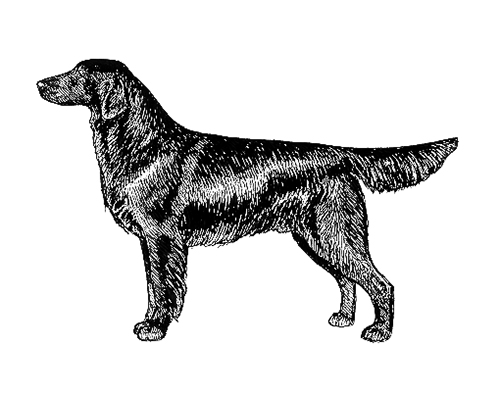Flat Coated Retriever
Gun Dog Group
The goals and purposes of this breed standard include: to furnish guidelines for breeders who wish to maintain the quality of their breed and to improve it; to advance this breed to a state of similarity throughout the world; and to act as a guide for judges.
Breeders and judges have the responsibility to avoid any conditions or exaggerations that are detrimental to the health, welfare, essence and soundness of this breed, and must take the responsibility to see that these are not perpetuated.
Any departure from the following should be considered a fault, and the seriousness with which the fault should be regarded should be in exact proportion to its degree and its effect upon the health and welfare of the dog and on the dog’s ability to perform its traditional work.
History
The breed was developed in Britain. It was probably the result of crosses of the St. John's Newfoundland, the setter, the sheepdog and spaniel-like water dogs. The founder of the Kennel Club of England, Mr. E. Shirley, did a great deal to promote the breed in the 1870s. It was developed to be a versatile hunting companion, and has remained that way into the present.
The Flat Coated Retriever was recognized by the United Kennel Club in 1984.
General Appearance
The Flat-Coat is a dog of distinct silhouette with its “one-piece” head, prominent prow, level topline and characteristically wagging tail. He is a balanced, utilitarian Retriever that has historically been described as showing “power without lumber and raciness without weediness.”
Characteristics
Correct temperament is a hallmark of this breed. It is endowed with great enthusiasm for work and play, natural hunting ability, boundless good humor and friendliness towards people and other dogs.
Head
The head is long and cleanly molded, giving the appearance of being “cast in one piece”.
SKULL
Moderately broad and flat. Stop is gradual and barely perceptible. Brows are slightly raised and mobile, giving life to the expression, which is intelligent and kindly. Cheeks are flat.
MUZZLE
is nearly as long and as broad as the skull, well filled in from eye to nose. Jaws are strong and the lips are clean and tight.
TEETH
A full complement of strong, white teeth meet in a scissors bite, which is preferred, but a level bite is acceptable.
EYES
Medium sized, almond shaped, dark brown or hazel, with fully pigmented, tight eye rims. Not obliquely placed.
NOSE
Large, with well opened nostrils, fully pigmented, black in the black dogs and brown in the liver dogs.
EARS
Relatively small, well set on, lying close to the side of the head and thickly feathered.
Neck
Moderately long, strong and slightly arched, free from throatiness, flowing smoothly into the well-laid-back shoulders.
Forequarters
Shoulder blades and upper arms long and well laid back to allow for efficient reach. Muscles smooth rather than bulky.
FORELEGS
The forelegs should be perfectly straight, with bone of good quality carried down to the feet. Pasterns strong and springy, with a slight slope. Dewclaws may be removed.
Body
Topline strong and level. Chest deep, moderately broad, with well-defined and prominent forechest. Rib cage deep showing good length from forechest to back rib, and only moderately broad. Loin strong, well muscled and at least long as it is wide, allowing for freedom of movement and length of stride. Moderate tuck up. Croup slopes slightly.
Hindquarters
Powerful, with angulation in balance with forequarter.
HIND LEGS
Stifle and hock joints strong, with good angulation. Rear pasterns short and parallel. No dewclaws.
Feet
Feet tight, with well-arched toes and thick pads.
Tail
Fairly straight, well set on as a smooth extension of the topline and reaching approximately to the hock joint; carried happily but without curl, never much above the level of the back.
Coat
Coat is of moderate length, dense, flat lying and free from curl, though some wave is allowable. Texture is fine and coat is glossy. Amount of coat should be sufficient to adequately protect the dog from all types of weather and cover, yet never bushy or overly profuse. The Flat-Coat should be shown with as natural a coat as possible. Minor tidying is allowable, but no shaving or barbering of the coat is permissible.
Color
Black or liver.
Height & Weight
The height is 23 to 24 inches at the withers for males, and 22 to 23 inches for females. Weight in hard, working condition for males is 60-80 pounds, for females 55-70 pounds.
Gait
From the side, movement appears effortless and well-coordinated. Front legs move forward with a long reaching action. Hindquarters reach well forward and well back to achieve a long stride in balance with the front movement. Topline is strong, level and supple while the dog is in motion. Viewed from the front or rear, the legs should turn neither in nor out, nor should the feet cross or interfere with one another.
Disqualifications
(A dog with a Disqualification must not be considered for placement in a conformation event, and must be reported to UKC.)
Unilateral or bilateral cryptorchid.
Viciousness or extreme shyness.
Albinism.

Looking for a Dog?
Find a dog that will fit your family.
Note: The breeders on this list are not endorsed by UKC.
Revised January 1, 2007
©Copyright 1992, United Kennel Club
